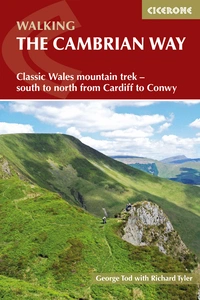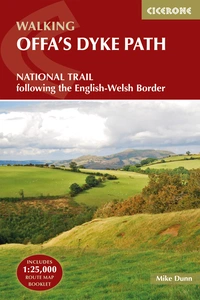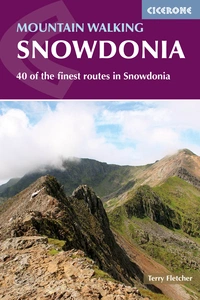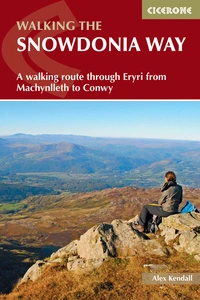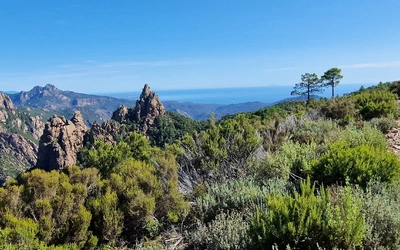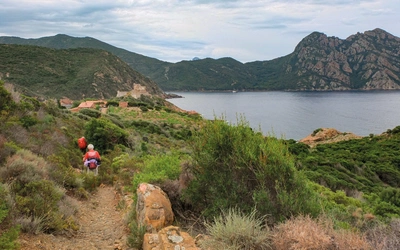An Introduction to The Cambrian Way
Are you an adventurous and experienced walker looking to discover Wales in a whole new way? Here's an introduction to the Cambrian Way – a challenging but rewarding long-distance route from Cardiff to Conwy, showcasing some of the best mountainous scenery that Wales has to offer.
The Cambrian Way
Classic Wales mountain trek - south to north from Cardiff to Conwy
£14.95
Guidebook to the Cambrian Way, a challenging three-week mountain trek through Wales from Cardiff to Conwy. The 470km route is presented from south to north. Often sticking to long, beautiful ridgelines, it crosses wild and rugged terrain and visits many of Wales's highest mountains, including Snowdon.
More informationIs the Cambrian Way a National Trail?
No, the Cambrian Way is not a National Trail – although that doesn’t mean it’s not a brilliant route! The official route has its origins in the 1960s when a small group of members of Ramblers (formerly The Ramblers Association) decided to look at the formation of a south–north trail running through the upland areas of Wales. Agreement could not be reached and the project would have failed without the determination of Tony Drake, a rambler with a passion for wild Wales. His work is carried on by the Cambrian Way Trust and Ramblers Cambrian Way Working Group.
What does 'Cambrian' mean?
Cambrian means ‘relating to Wales’, so the Cambrian Way is simply a way to walk through Wales. It’s also referred to as the mountain connoisseurs’ walk as it showcases some of the best mountainous scenery that Wales has to offer (including Snowdon).

Where does the route start and end?
The Cambrian Way starts in the middle of Cardiff at the main entrance to the impressive castle. After leaving the city it passes through Bannau Brycheiniog (Brecon Beacons National Park), traversing the iconic Pen y Fan mountain.
It then leads through the Carmarthen Fans with their legendary Llyn y Fan Fach lake. Beyond Llandovery the countryside becomes more remote and wild as the route enters the Elenydd region and crosses Pumlumon.
There is a challenging traverse of Cadair Idris, and a brief glimpse of the sea when crossing the Barmouth viaduct. A stiff ascent leads to Rhinog Fach and Rhinog Fawr where there are views north to Snowdon. The route ends with a descent to the coast at Conwy Castle.
How long is the route?
The Cambrian Way is 479km (298 miles) in total with around 22,500m (73,700ft) of ascent.
How difficult is the Cambrian Way?
Tempting as it may be, the Cambrian Way should not be the first outing attempted by the novice trekker. It's nearly 300 miles long and much of the route is in open access country, requiring good navigational skills. Some sections are long and remote, and accommodation can be rudimentary. While the mountains are not high, reaching a little over 1000m, the isolation and the challenge of the highest peaks require good mountain walking experience.
How many days are needed to complete the route?
The route takes around 3 weeks to walk, although it can be made shorter or longer depending on your timeframe and fitness.
What accommodation options are available?
There is a wide range of accommodation along the Cambrian Way, from youth hostels, bunkhouses, bothies and campsites to expensive hotels. There are many B&B establishments on the route. There is a detailed accommodation list on the Cambrian Way website. Note that wild camping in Wales is only allowed with the landowner's permission.
With often quite long distances between accommodation it is unwise to arrive without booking in advance. It is safest to book for the whole route or the part of the route you’re walking before setting off so that you can be assured of a bed for the night.
Is it well waymarked?
Much of the Cambrian Way is waymarked with the Welsh hat symbol or on marked public rights of way. Substantial parts of it are over open access country and mountain ridges and peaks where paths are not always clear. Often there can be a confusion of paths, many of which may be sheep tracks. For these reasons it is necessary to have good map-reading skills, particularly if visibility is bad.
When is the best time to go?
The route can be attempted at any time of the year but the higher mountains of the Snowdonia area are best avoided in the middle of winter due to wind, ice and snow. Some hostels close for the winter, but it is possible to find B&B accommodation throughout the year – although this of course should be checked in advance. Wales is renowned for its rainfall so walkers should always be prepared for wet weather.
Can I use public transport to travel to and from the route?
Getting to Cardiff at the start of the Cambrian Way and from Conwy at the end is easy by road or rail. Cardiff is on the South Wales Main Line which offers connections with stations across the UK and a direct link with London. Conwy is on the North Wales Coast Line which runs from Crewe to Holyhead, Crewe being a major junction with good connections to both the north and south. The National Rail website and Trainline allow you to compare options and make rail bookings, and both train and bus information can be found at www.traveline.cymru.
There are good bus services in the urban districts and on main roads in the countryside, should you want to leave the route in order to take advantage of wider accommodation options. If walking the route in sections rather than in one go, railways can be used to reach many spots along the Way.
What should I take with me?
- Pack weight should be between 7 and 10kg, depending on whether camping gear is being carried. It is well worth investing in lightweight equipment, as some of the mountain sections are difficult to negotiate with a large pack.
- Although much of the southern section can be walked in good mountain shoes, boots are advisable for the later sections, as well as gaiters for the peat bogs in the mid moorland areas where streams will also need to be waded on occasion.
- Sun cream and insect repellent are advisable. Trekking poles can be very useful for the more mountainous and boggy sections. Safety items such as a first aid kit, torch, whistle, map and compass are essential.
- Sheets are not usually required for hostels but it is wise to a carry light silk inner lining and pillow cover. For bothies, a sleeping bag and mat will be needed.
- The logistics of washing and drying clothes over a three-week trek will need to be considered; liquid soap and a drying line are recommended, although many accommodation businesses will provide laundry services at a charge.
- A few remote sections require enough food to be carried for a few days.
What are the stages of the Cambrian Way?
| Stage | Start / Finish | Distance | Time |
|---|---|---|---|
| 1 | Cardiff to Machen | 24.5km (15¼ miles) | 6–7¼hr |
| 2 | Machen to Pontypool | 18.5km (11½ miles) | 5¾–6¾hr |
| 3 | Pontypool to Abergavenny | 20km (12¼ miles) | 5–6¼hr |
| 4 | Abergavenny to Capel-y-ffin | 21.5km (13¼ miles) | 6¼–8hr |
| 5 | Capel-y-ffin to Crickhowel | 26.5km (16½ miles) | 7–9hr |
| 6 | Crickhowell to Storey Arms | 33.5km (21 miles) | 9¾–12½hr |
| 7 | Storey Arms to Glyntawe | 19km (11¾ miles) | 5–6¼hr |
| 8 | Glyntawe to Llandovery | 29.5km (18½ miles) | 8¼–10¾hr |
| 9 | Llandovery to Tŷ’n-y-cornel | 26km (16 miles) | 6¾–8½hr |
| 10 | Tŷ’n-y-cornel to Claerddu | 23.5km (14½ miles) | 6¼–7¾hr |
| 11 | Claerddu to Ponterwyd | 24km (14¾ miles) | 6½–8¼hr |
| 12 | Ponterwyd to Dylife | 23.5km (14½ miles) | 6½–8¼hr |
| 13 | Dylife to Dinas Mawddwy | 37km (23 miles) | 10–12¾hr |
| 14 | Dinas Mawddwy to Bwlch Llyn Bach | 15.5km (9½ miles) | 5–6¾hr |
| 15 | Bwlch Llyn Bach to Barmouth | 20km (12½ miles) | 5¾–7½hr |
| 16 | Barmouth to Cwm Bychan | 23km (14 miles) | 8½–10¾hr* |
| 17 | Cwm Bychan to Maentwrog | 16km (9¾ miles) | 5½–7hr* |
| 18 | Maentwrog to Beddgelert | 22km (13½ miles) | 7–8¾hr |
| 19 | Beddgelert to Pen-y-Pass | 17.5km (10¾ miles) | 5¾–7¾hr |
| 20 | Pen-y-Pass to Llyn Ogwen | 8.5km (5½ miles) | 4–5hr* |
| 21 | Llyn Ogwen to Conwy | 30.5km (19 miles) | 9–11½hr |
What guidebook should I use?
Our guidebook presents the route in 21 stages, offering comprehensive route description illustrated with OS 1:50,000 mapping and elevation profiles. Details of accommodation and facilities are provided, along with a helpful trek planner showing their distribution along the route. There are background notes on Wales's history and geology and local points of interest, and a glossary of Welsh place-names, useful contacts and accommodation listings can be found in the appendices, plus GPX files are available to download.
The Cambrian Way
Classic Wales mountain trek - south to north from Cardiff to Conwy
£14.95
Guidebook to the Cambrian Way, a challenging three-week mountain trek through Wales from Cardiff to Conwy. The 470km route is presented from south to north. Often sticking to long, beautiful ridgelines, it crosses wild and rugged terrain and visits many of Wales's highest mountains, including Snowdon.
More information
